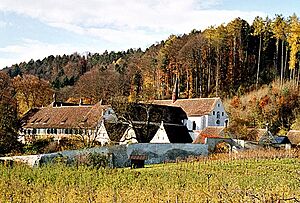Warth-Weiningen facts for kids
Quick facts for kids
Warth-Weiningen
|
||
|---|---|---|
|
||
| Country | Switzerland | |
| Canton | Thurgau | |
| District | Frauenfeld | |
| Area | ||
| • Total | 8.21 km2 (3.17 sq mi) | |
| Elevation | 445 m (1,460 ft) | |
| Population
(Dec 2020 )
|
||
| • Total | 1,365 | |
| • Density | 166.26/km2 (430.6/sq mi) | |
| Postal code |
8532
|
|
| Surrounded by | Felben-Wellhausen, Frauenfeld, Herdern, Hüttwilen, Pfyn, Uesslingen-Buch | |
Warth-Weiningen is a small town, also called a municipality, located in the Frauenfeld area. It is part of the canton of Thurgau in Switzerland. In 1995, the two smaller towns of Warth and Weiningen joined together to form this single municipality.
Contents
Geography of Warth-Weiningen
Warth-Weiningen covers an area of about 8.2 square kilometers (3.2 square miles). A large part of this land, about 53%, is used for farming. Forests cover almost 29% of the area. About 13% of the land has buildings or roads on it. A small amount, around 3%, is made up of rivers or lakes. The rest, about 2%, is land that cannot be used for farming or building.
Most of the built-up areas are industrial buildings, roads, and places for sports. In the forests, most of the land is covered with thick trees. For farming, people mainly grow crops. There are also some areas with orchards or vineyards.
People of Warth-Weiningen
Warth-Weiningen has a population of about 1,174 people. Most people in the municipality speak German, which is 97.3% of the population. A small number of people also speak English or Portuguese.
The population of Warth-Weiningen has grown over the years. Here is how the population has changed:
| year | population |
|---|---|
| 1950 | 562 |
| 1960 | 585 |
| 1980 | 675 |
| 1990 | 996 |
| 2000 | 1,131 |
In 2009, the age groups in Warth-Weiningen were:
- Children (0-9 years old): 9.2%
- Teenagers (10-19 years old): 11.6%
- Young adults (20-29 years old): 11.8%
- Adults (30-59 years old): 45.8%
- Seniors (60 years and older): 21.6%
Important Sights in Warth-Weiningen
One very important place in Warth-Weiningen is the Carthusian Ittingen Monastery. This old monastery is recognized as a special part of Swiss heritage. It is a place with a lot of history.
Economy of Warth-Weiningen
In Warth-Weiningen, people work in different types of jobs.
- The primary economic sector involves jobs like farming. About 63 people work in this area.
- The secondary sector includes jobs in manufacturing and making things. About 97 people work here.
- The tertiary sector is about services, like shops, offices, and tourism. About 268 people work in this sector.
Many people who live in Warth-Weiningen travel to other towns for work. About 52% of the residents work outside the municipality. Also, some people travel into Warth-Weiningen for their jobs. About 53% of working people use a private car to get to work, while about 10% use public transportation.
Religion in Warth-Weiningen
Based on information from 2000, the main religions in Warth-Weiningen are:
- Swiss Reformed Church: 56.4% of the population
- Roman Catholic: 31.1% of the population
A smaller number of people belong to other Christian churches, the Orthodox Church, or Islam. Some people also stated they have no religion.
Education in Warth-Weiningen
Many adults in Warth-Weiningen have completed higher education. This means they have gone to a university or a similar school after finishing their regular schooling.
The municipality has its own primary school district. In the 2008-2009 school year, there were 106 students in total.
- There were 24 children in kindergarten.
- There were 40 children in the lower primary school levels.
- There were 42 children in the upper primary school levels.
The average class size in the primary school was about 16 students.
See also
 In Spanish: Warth-Weiningen para niños
In Spanish: Warth-Weiningen para niños





